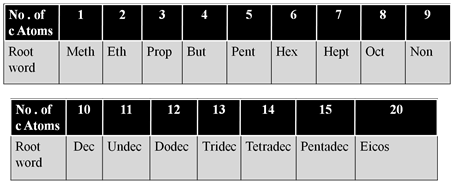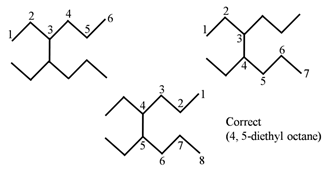- Books Name
- Kaysons Academy Chemistry Book
- Publication
- Kaysons Publication
- Course
- JEE
- Subject
- Chemistry
Nomenclature
When organic compounds were discovered, the names were assigned by people who discovered it. These names were in general derived from Greek literature or day today usage: example the word Methanol (CH3OH) was derived from Methylic (Greek methu wine and hyle wood; wood alcohol), formic acid (Latin formica ant found in ants). Butyric aldehyde (Latin butyrum butter; found in butter),

Some Common Names

So when the number of iso compounds increased the naming become difficult to understand. In 1958 – IUPAC (International Union of Applied Chemistry) govern made rules that nomenclature rules. IUPAC decides on all matters related to naming of all chemical compounds. (organic, Inorganic Coordination etc).
These rules are updated every few years. The lost update was in 2005-06. Any organic name can be broken into five parts. (animation)
![]()
(1) Root ward
This depends upon the number of carbon atoms is a suitable chain, called the parent Chain.

Ex:- If it is six carbon root war-Hex.
Primary suffix
Is added to indicate saturation or unsaturation in the parent chain.

Secondary Suffix
Indicate the principal functional group. When adding secondary suffix ‘e’ of the prim suffix is removed if – the secondary suffix starts with a vowel or ‘y’ otherwise ‘e’ is retained.
Primary Prefix
Indicate the substance attached to the parent chain. Certain functional groups are never put in suffix always as a prefix. Such as Cloro, Bromo, Iodo, nitro (NO2), alkyl(R), methoxy(OCH3) etc. In the case of cyclic compounds, cyclo become the primary prefix. And other substituent’s go-to secondary prefix. There can be more than are primary prefix.
Secondary prefix
Substitutes in cyclo compounds and Di, Tri etc in others denoting no of substitutes.
Nomenclature rules can be broken into four parts. This makes the process a little easier to understand.
Part A – Saturated and branched alkanes
Part B – Unsaturated compounds and compounds with functional groups.
Part C – Cyclic (only monocyclic)
Part D – Aromatic (only benzene and its derivative)
Nomenclature Rules – Saturated and Branched Chain

1. Select the longest chain (called parent Chain), which may or may not be straightforward to determine the root word. Ex:-1
Hello

 Kaysons Publication
Kaysons Publication
